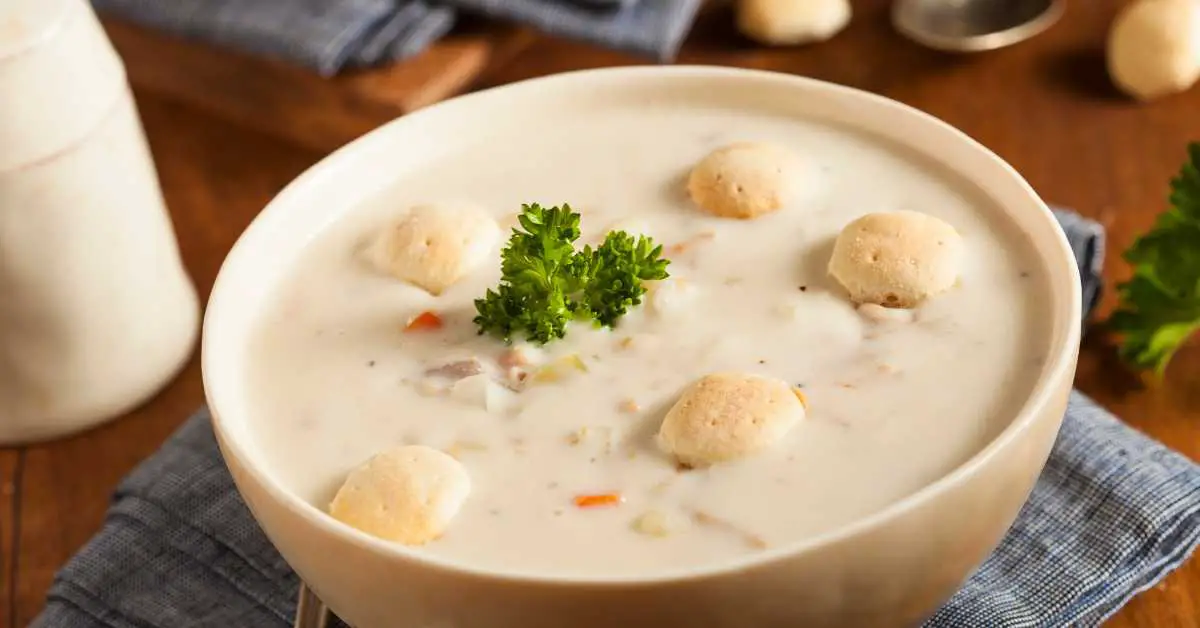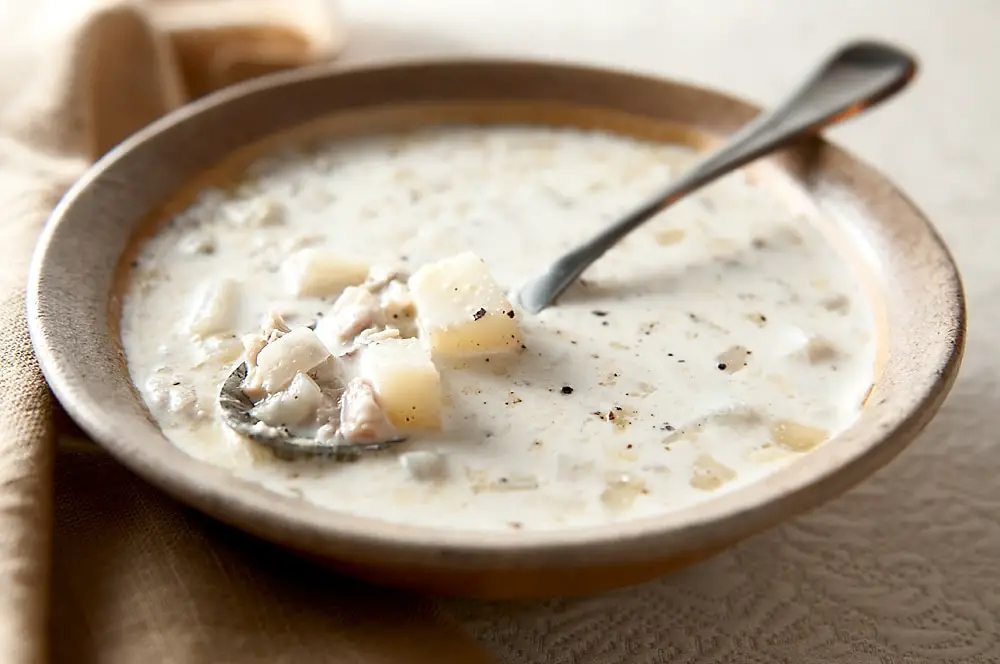Ah, clam chowder. A creamy, comforting soup that warms the heart and soul, especially during soup season. Whether you’re savoring a bowl of clam chowder in a cozy New England eatery or following your favorite easy soup recipe at home, the question of how long clam chowder is good for has probably crossed your mind. Don’t worry, you’re not alone.
A Brief History of Clam Chowder
Clam chowder has a rich history, deeply rooted in the coastal regions of the United States. The first thing to note is the different versions of clam chowder. There’s the creamy New England clam chowder recipe that features a creamy broth made from heavy cream and full of fresh clams. There’s also Manhattan clam chowder, a tomato-based broth variant teeming with bell peppers and other vegetables.
The Basics of Clam Chowder Preparation
The best clam chowder recipe begins with simple steps. For New England clam chowder, you start with salt pork or bacon drippings, sautéed in a large pot or Dutch oven over medium heat. Add in diced Yukon gold potatoes or red potatoes and onions, followed by a little salt and black pepper. Then comes the chicken stock or chicken broth, fresh thyme, a bay leaf, and a little white wine if you’re feeling adventurous.
Clam Juice: The Heart of the Chowder
Of course, no chowder would be complete without clam juice. For the best results, you can use fresh clams, but canned clams and their juice also work perfectly. Some clam chowder recipes may call for clam stock or clam broth, which adds a deeper, more natural flavor. Pour this in, stir, and let the mixture simmer until the potatoes are tender. Finish off with a bit of half cream or whole milk for a deliciously creamy clam chowder.
Key Ingredients for Clam Chowder
- Fresh clams or canned clams
- Yukon gold potatoes or red potatoes
- Chicken broth or chicken stock
- Heavy cream or whole milk
- Fresh thyme and a bay leaf
USDA Guidelines for Chowder Storage
According to USDA guidelines, there are three key factors to consider when storing clam chowder: temperature, airtight storage, and time.
Temperature
The best way to store clam chowder is to keep it at room temperature for as little time as possible. This is because harmful bacteria can multiply rapidly at room temperature, increasing the risk of food poisoning.
Airtight Storage
Store the leftover clam chowder in an airtight container or a freezer bag to preserve its good flavor and keep it in good condition. A vacuum sealer can also be handy for this purpose.
Time
In general, clam chowder can be kept in the refrigerator for 3-4 days and in the freezer for 4-6 months for the best results.
Grocery Store Vs. Homemade: Shelf Life Differences
When it comes to shelf life, there’s a significant difference between homemade soups and canned soup from the grocery store. This is largely due to the preservatives found in canned food, allowing it to have a long shelf life. Canned clam chowder, for example, can last for a long time (up to 5 years) if stored unopened in a dry place.
On the other hand, homemade clam chowder, made with fresh and delicate ingredients, like dairy products and fresh clams, doesn’t have this long shelf life. But the trade-off is an easy clam chowder recipe that’s filled with real ingredients and bursting with flavor. You’re in control of every element, from the type of clam chowder you make to the thickness of your creamy broth. It’s an opportunity to experiment with different flavor profiles and textures, perhaps adding a touch of lemon juice or a sprinkle of hot sauce for a little kick.
Expiration Date: Not the Only Thing to Consider
While canned clam chowder has an expiration date printed on its label, it’s crucial to remember that this date is just a guide for the grocery store. It tells the store how long to display the product for sale, but it doesn’t mean the soup is unsafe after this date. However, it’s always a good idea to check the condition of the can. Any bulges, dents, or leaks should be a cause for concern.
For homemade clam chowder, the expiration date is a bit more subjective. As mentioned, refrigerated chowder lasts for about 3-4 days, but it’s always best to check for any bad smells or changes in texture before digging in.
Reheating: Achieving Restaurant-Worthy Clam Chowder at Home
Now that you have your leftover clam chowder safely stored, you might be wondering about the best way to reheat it for your next meal. Here’s where a little finesse comes in to achieve a restaurant-worthy clam chowder.
Start by transferring your chowder to a soup pot and heat it over medium heat. Stir it gently to distribute heat evenly and prevent it from sticking to the bottom of the pot. If you find the soup too thick, add a little bit of chicken broth or even a bit of clam juice to thin it out. Once it’s heated through, it’s ready to serve, ideally with a side of oyster crackers for some added crunch.
Different Ways to Enjoy Leftover Clam Chowder
Leftover clam chowder can be more versatile than you might think. Sure, you can enjoy it as is, perhaps with a sprinkle of fresh thyme or a dash of hot sauce to liven it up. But, if you’re up for trying new recipes, here are a couple of other ways to use it:
- Clam Chowder Poutine: Replace the traditional gravy with clam chowder in this Canadian classic. Top your fries with cheese curds, then pour a generous amount of heated chowder over the top.
- Clam Chowder Pot Pie: Use your leftover chowder as the filling for a comforting pot pie. Simply top it with a pastry crust and bake until golden.
- Seafood Pasta: Reduce your chowder on the stove until it thickens, then toss it with some pasta for a seafood twist on mac and cheese.
Remember, creativity in the kitchen can lead to some of the most delightful dishes!
Summary
In conclusion, the shelf life of clam chowder depends largely on how it’s stored. Following USDA guidelines, leftover clam chowder should be refrigerated and consumed within 3-4 days for the best results. However, canned clam chowder from the grocery store can last unopened for years thanks to the preservatives it contains.
Regardless of whether you’re reheating a bowl of leftover New England clam chowder or opening a can of Manhattan clam chowder, always check for signs of spoilage before eating. And don’t forget, leftover clam chowder can be the start of many creative and delicious dishes, so don’t be afraid to experiment and try something new!










